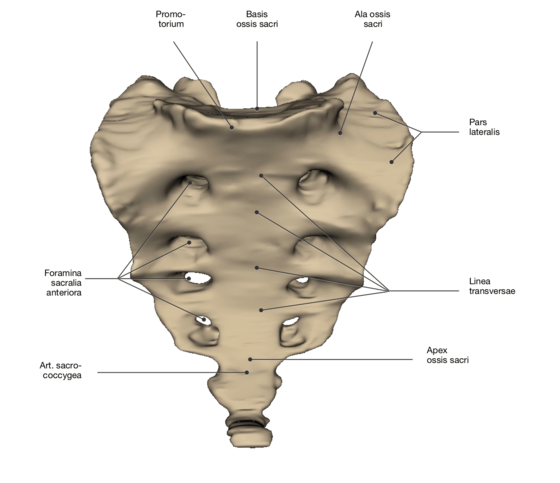Kreuz- und Steißbein/en: Unterschied zwischen den Versionen
Becher (Diskussion | Beiträge) (Die Seite wurde neu angelegt: „==View from dorsal==“) |
Becher (Diskussion | Beiträge) (Die Seite wurde neu angelegt: „The uneven, irregular, convex rear surface (<i>Facies dorsalis</i>) has three characteristic mountainous ridges, which can vary in appearance: File:KreuzDors…“) |
||
| Zeile 14: | Zeile 14: | ||
==View from dorsal== | ==View from dorsal== | ||
| − | + | The uneven, irregular, convex rear surface (<i>Facies dorsalis</i>) has three characteristic mountainous ridges, which can vary in appearance: | |
| − | [[File:KreuzDorsal.png|600px|right| | + | [[File:KreuzDorsal.png|600px|right|dorsal view of the sacrum and coccyx]] |
Version vom 2. Januar 2020, 14:06 Uhr
View from ventral
The sacrum (Os sacrum) is a triangular bone and originally consists of five independent sacral vertebrae (Vertebrae sacrales, S1-S5).
It was formed by the fusion of the five cross vertebrae and the intermediate intervertebral discs (Discus intervertebrales). It belongs to the immobile part of thespine. The sacrum has a forward concave surface (Facies pelvina), the dorsal surface (Facies dorsalis) is convex. The tip of the sacrum (Apex ossis sacri), positioned caudally, is connected to the coccyx. Dorsally of the sacrum, there are five bone ridges (longitudinal ridges), which emerged from the spinous, articular and transverse processes. Between the foramina sacralia anteriora are the four transverse lines of the fused vertebral bodies (line transversae). Furthermore, the passage (Foramina sacralia pelvina) for the spinal cord nerves (spinal nerve) is located there.
The coccyx (Os coccygis) on the other hand consists of three to four rudimentary vertebrae. Only the first coccygeal vertebrae still shows a typical structure of a vertebra. The size of the coccyx decreases distally. From the first coccygeal vertebra arise two bony articular processes, the so-called coccygeal horns (Cornua coccygea). The coccyx also has short transverse processes and is generally connected to the tip of the sacrum by a cartilaginous (Sacrococcygea) process. This enables a passive forward and backward movement of the coccyx. From the age of mid-20, this mobility decreases due to mineralization.
View from dorsal
The uneven, irregular, convex rear surface (Facies dorsalis) has three characteristic mountainous ridges, which can vary in appearance:
- Crista sacralis mediana:
ist die Vereinigung der Dornfortsätze, die in der Mitte eine gezackte Knochenleiste bilden
- Crista sacralis medialis (paarig):
lateral davon durch Verschmelzung der Gelenkfortsätze entstanden
- Crista sacralis lateralis (paarig):
entstanden aus der Verschmelzung der Querfortsätze, verläuft lateral der Foramina sacralia posteriora
Der Wirbelsäulenkanal (Canalis sacralis) endet kaudal an der unteren Öffnung des Kreuzbeins (Hiatus sacralis). Sie entsteht durch den nicht ausgebildeten fünften Wirbelbogen, der zwischen den Cornua sacralia liegt. Durch Verschmelzung der Querfortsätze entsteht beiderseits die seitlichen Anteile des Kreuzbeins (Pars laterales), an deren Seiten die ohrenförmigen Gelenkflächen (Facies auriculares) für die Darmbeine liegen.
weiterführende Links

